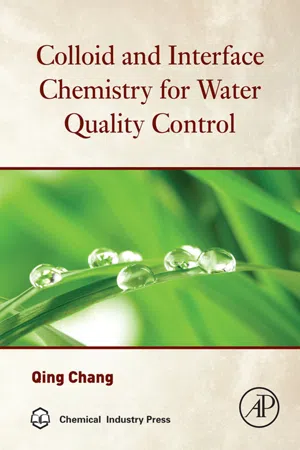
- 276 pages
- English
- ePUB (mobile friendly)
- Available on iOS & Android
Colloid and Interface Chemistry for Water Quality Control
About This Book
Colloid and Interface Chemistry for Water Quality Control provides basic but essential knowledge of colloid and interface science for water and wastewater treatment. Divided into two sections, chapters 1 to 8 presents colloid chemistry including simple history and basic concepts, diffusion and Brown Motion, sedimentation, osmotic pressure, optical properties, rheology properties, electric properties, emulsion, foam and gel, and so on; chapters 9 to provides interface chemistry theories including the surface of liquid, the surface of solution, and the surface of solid. This valuable book is the only one that presents colloid and interface chemistry from the water quality control perspective. This book was written for graduate students in the area of water treatment and environmental engineering, and it could be used as the reference for researchers and engineers in the same area.
- Concise content makes this suitable for both teaching and learning
- Focuses on water treatment technology and methods, links colloid and surface chemistry to water treatment applications
- Not only addresses all the important physical-chemistry principles and theories, but also presents new developed knowledge on water treatment
- Includes exercises, problems and solutions, which are very helpful for testing learning and understanding
Frequently asked questions
Information
Brief History of Colloid and Interface Chemistry and Basic Concepts
Abstract
Keywords
1.1. Origin of the term “colloid”
Table of contents
- Cover
- Title page
- Table of Contents
- Copyright
- Preface
- Chapter 1: Brief History of Colloid and Interface Chemistry and Basic Concepts
- Chapter 2: Diffusion and Brownian Motion
- Chapter 3: Sedimentation
- Chapter 4: Osmotic Pressure
- Chapter 5: Optical Properties
- Chapter 6: Rheology Properties
- Chapter 7: Electrical Properties
- Chapter 8: Surface of Liquid
- Chapter 9: Surface of Solution
- Chapter 10: Surface of Solids
- Chapter 11: Emulsion, Foam, and Gel
- Appendix A
- Appendix B
- Appendix C
- Further Reading
- Index